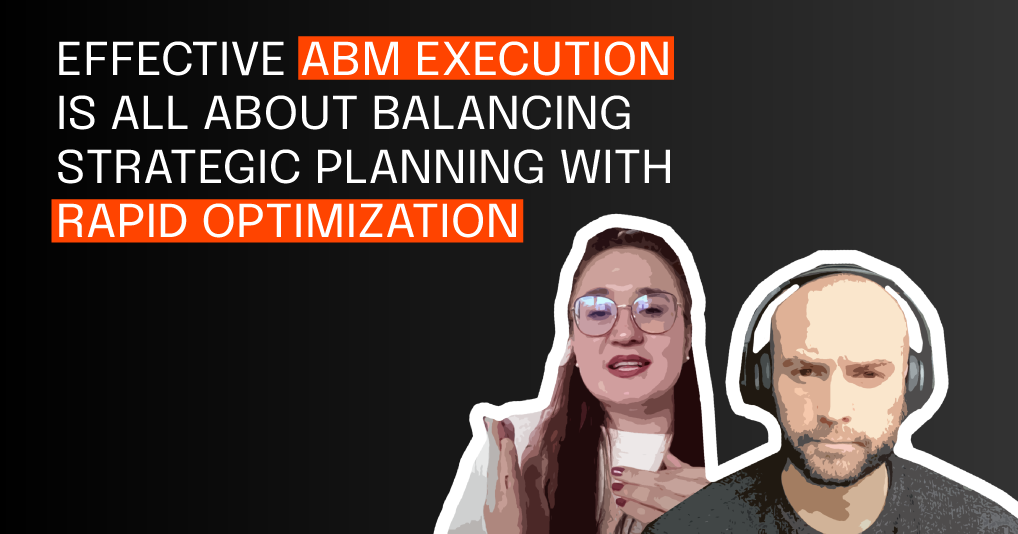Setting objectives for ABM (Part 2)
14 November 2023
Jack Rawlings & Josh Weale ▪︎ Heads of ABM
Part 2 has landed! Go back under the hood of ABM objectives, and hear from our Heads of ABM as they conclude their discussion around the challenge of setting the right objectives for your business.


Josh is a Head of ABM, leading the development of innovative strategies to help enterprise tech businesses win, grow and retain their most important accounts. With a background in journalism and several years of client-side experience, he works with Sales and Marketing teams to help them succeed.
ABM Lunch and Learn
Fast forward your team's ABM learning and accelerate your growth
We’re on a mission to create great ABMers
Subscribe to our ABM insights and podcast releases.
Welcome to Part 2 of Setting Objectives for ABM
Ready to go back under the hood? Setting the right ABM objectives is no easy feat – but Jack and Josh are here to help you hit the ground running.
No one ever said setting ABM objectives would be easy. But that doesn't mean it has to be a total stab in the dark. You just need the right guidance on your journey.
Part 2 has landed, and we have plenty more tips and tricks up our sleeves. From spotting the indicators of success to what a 'good' or 'bad' objective looks like, to securing alignment across your organization – the two Js cover it all!
Read Podcast Transcript
Check out Part 1 of this two-part series on setting objectives for ABM here.
Jack Rawlings (strategicabm) – Welcome to Part 2 of objective setting. In Part 1, we explored North Star objectives, what 'bad' looks like, mistakes, and much more. So if you missed it, go take a look! In this episode, we're continuing the conversation, and exploring everything from the indicators of success to securing alignment on objectives, to the value of transparency, and much more. So get ready to go back under the hood!
Identifying Good vs. Bad Objectives
Jack (strategicabm) – I guess a good question to ask, probably, at this point is around good and bad objectives for an ABM program. And I know that this is going to be very much contextual to a business, you know, where a business is at and what they're looking to achieve, et cetera. But is there anything, you know, specifically, you would say is a bad objective for an ABM program? Anything that you think, "ABM is just not meant for this, shouldn't be used in that way"?

Josh Weale (strategicabm) – Yeah, it's a really good question. And I think it's a difficult one to answer, because objectives, I suppose, they are contextual to where a business is, and how mature that business is, and what they're trying to do.
I think, as a, kind of, broad answer, I would say there's no really terrible objectives to have, as long as it's, kind of, relevant to what you're trying to do within the ABM program. I think the bigger issue comes when you're trying to measure, kind of, maybe it's the right thing, but in the wrong place.
Like we were just talking about, about trying to measure revenue, kind of, metrics and objectives within the first three months, when the campaign itself isn't actually designed to drive those kinds of conversations.
So, I don't necessarily think there's a bad objective as such, unless you've got another thought about that. But from my perspective, it's about making sure that what you are trying to measure is relevant and that it's actually driving towards that bigger goal. So yeah, that would probably be what I would say about that.
Jack (strategicabm) – Yeah, I think, I mean, I completely agree. I think the only time I would say there is something you could maybe consider a bad objective is when it's bad for a business context.
So, if for a specific business, essentially they want to bring in huge numbers of contacts into their database. They want, like, warm leads, right? From an ABM perspective, like, that can absolutely be an objective. And it might well be that, depending on where the business is, that's the right objective to have for the ABM program at that time.
But, for other businesses, that's potentially not the right approach, because it's making them focus on the wrong things, right? They're focusing on the individual contacts. You know, you can buy contact data. You can do Lead Gen programs that will get that in. And actually, that's not really going to help them get to the place where they actually want to get to.
So, I guess what I'm saying is the time when an objective might not be the right one is when, actually, it's kind of masking, or acting in place of, the real objective. The real objective isn't getting warm leads or contacts in a database. The real objective is getting to revenue, right? That's the real objective.
Indicators of Success in ABM
But, in a way, they've perceived that the leading indicators are these. So, they're the wrong leading indicators to be taking notice of, in a way, and setting those leading indicators as objectives in and of themselves.
Josh (strategicabm) – Yeah.
Jack (strategicabm) – Which I think is sometimes what causes issues for businesses, 'cause they say, "Right, well, why can't we... ? If we add more budget or, you know, have more campaigns running, we could get more leads coming through and more contacts through." And it's kind of like, "Yes, but is that going to help us actually get to the revenue?" 'Cause how many of those are actually going to convert and move along the journey? So, I think that's one, sort of, type of objective that's not necessarily the best to have, you know, broadly speaking.
Josh (strategicabm) – Yeah, I think it's a really good point. And it's about considering, kind of, available resource, like anything... We know that working in ABM, it's still relatively new for a lot of businesses, and because of that, it starts out quite small, as, like, a pilot program. Maybe you've got one Marketer, one Salesperson. Like, that's a very limited, kind of, amount of resource to be expected to, kind of, do great things.
But it's not saying that great things aren't possible, it's just that you have to be very focused about what's going to drive business value as quickly as possible to be able to then justify investment in more and more resources.
So, if you've got an objective which is, kind of, leading you down the wrong path and taking away from that resource and becoming a distraction, then I suppose, in the context of your question, that could be seen as, like, a bad objective, because that, kind of, goes down as wasted resource – or maybe not wasted resource, but, kind of, misaligned resource, and then it takes you longer to actually achieve what you're trying to do.
Jack (strategicabm) – Yeah, yeah. And I think about an example, as well, with a client that I've worked with, where they were looking to, you know, get an ABM program up and running and start seeing the results from that program. But they were very well aware of the limitations: A) of the resources; and B) of the budget that they had in the early stages.
And also, as well as that, the limitations of things like content – they didn't have much content created. They didn't have a particularly great website at the time. Lots of, almost, foundational, sort of, fundamental things that needed fixing or organizing first. And they were aware of that and patient about the need to get that stuff fixed, first of all.
So, the first 6, 12 months of the program was almost that. It wasn't necessarily a full ABM program as we would, kind of, define it. It was more about setting up all of the infrastructure and resources that were needed for a longer-term ABM program to then, sort of, come to fruition.
And because we did that, sort of, setup phase and that foundational phase, then the next 12 months were a lot easier. We started seeing results coming through based on, you know, moving accounts from one stage to the next, and eventually getting deals and opportunities and revenue coming through, you know, after that, sort of, into that second year.
But if that client had come to us with the objective of, "We need to get revenue and pipeline year one," and with what we knew – after we'd, kind of, evaluated their website, their content, the resource that they had available, all of that – that would've been a bad objective, or an objective that we wouldn't have necessarily agreed to as an Agency working with them – because of where they were at.
Again, it's that context of where they're at and how long it would take to get them to that place of revenue. So, I think, yeah, as you say, it's not necessarily that there are bad objectives, it's just that there are bad objectives contextually to the place where a business is at that moment in time, depending on their situation, their resources, their circumstances, all of that.
Josh (strategicabm) – Yeah, absolutely.
Jack (strategicabm) – Flipping it the other way around then, is there such a thing as a good objective in ABM? Is there anything that you think, you know, all ABM programs or most ABM programs should focus on, should be built around?
Josh (strategicabm) – Yeah. I mean, again, it's similar to the previous question. I don't think there's good or bad objectives that are universal, because a good objective to one company may not work for another.
But I think, when we are talking about, kind of, what does success look like in an ABM program, I'll go back to, kind of, the Three Rs model and think about Reputation, Relationships and Revenue. And there's some really key metrics that I always look out for that I think are good indicators of whether an ABM program is successful.
The Power of Transparency & Reporting
And from a, kind of, measurement point of view, I think there's definitely account engagement and understanding, kind of, touchpoints within an account. How many times are you getting an account engaging with your content? How many times do they turn up to events, webinars, having conversations with the Sales team – whether that's social selling or offline, or by email.
Account engagement metrics like that are a really good indicator – especially if you can compare it to pre-ABM campaign versus in the ABM campaign, because that gives you an indicator of, I suppose, the frequency, as well. If it increases, then that's a good thing.
And then, there's also metrics around, kind of, the account's footprint and the footprint that you have within the account. If you, kind of, start in an ABM program and you've got three or four stakeholders within the account and you're trying to, kind of, win a larger deal in there, you know that there's certain stakeholders that you need to be engaged with.
Maybe you've not been able to engage with them before. But if the ABM program can then unlock those stakeholders, and you can see in your CRM that you're having conversations with them, you're getting them to engage with different pieces of content, they're proactively seeking out you to, kind of, talk about the solutions and stuff that you offer, and that's a real positive step, and that, kind of, sign of relationships growing, that's really important.
Alongside that, things like net new contacts within the database. If you can, kind of, show a positive trend there, then that's great. And then ultimately, if we go on to the revenue perspective, it ultimately comes down to pipeline, deal velocity, deal size. If you can, kind of, show positive trends there, then your ABM program's going great guns, because you're able to directly show the business how reputation and relationship has correlated to increased revenue opportunities.
So, I think, to answer the question, it's not necessarily about an objective being good in of itself, but it's about being able to tell that story about how these groups of objectives all add up together to show overall business impact.

Jack (strategicabm) – Yeah, yeah, 100%. And I guess, as well, you know... when you've understood the impact of each, kind of, stage of those, sort of, Three Rs, there's objectives that tie to those. That's what you can feed back to the business, right?
So, you can say, "Right, the objective of months three to six of this program," for example, "is going to be purely focusing on awareness. If we get anything else coming through, great. If we get some leads or we get some conversations started, fantastic. But ultimately, the goal here is to build that level of awareness. And what we're looking to do, so our overarching objective for this part of the program, or this part of the campaign, is to get, let's say, awareness within 90% of the accounts that we're targeting".
You know, sort of, plucking a number out of the air. But, you know, the goal is to hit that amount of, kind of, coverage within these accounts. And then, months six to nine, maybe it's about moving, you know, 30% of those accounts to the point where you've built a relationship with them, whatever that might mean from a, sort of, specific metrics perspective.
And then, you know, the next three months, it might be moving X number of those into opportunity stage, or deal stage. The fact is, I think, having an overarching objective for the whole program that, kind of, sits above that is really important, and one thing to be aware of.
But then also, having that, sort of, time-specific or stage-specific, kind of, North Star goal is also super important, right? Because otherwise, it's a little bit like, you know, you're not necessarily going to be able to demonstrate the impact and the efficacy of a program until you've hit that overarching North Star objective, right, if you haven't got these other objectives that sit underneath.
You know, you might want to call them those, sort of, leading indicators, or you might want to say that each stage has its own objective that you're kind of trying to hit. And by doing that, it gives you the opportunity to, kind of, move on, you know, and do well in the next stage, as well.
Josh (strategicabm) – Yeah, yeah, definitely.
Aligning Sales & Marketing on ABM Goals
Jack (strategicabm) – So, I guess another, kind of, question or key consideration when it comes to objective setting is, well, Sales and Marketing alignment. I mean, from a perspective of both getting Sales and Marketing alignment, but also ensuring that there is Sales and Marketing alignment on the goals and objectives and how to, kind of, achieve that.
So, how would you, kind of, approach this? What would you say is the most important consideration when it comes to Sales and Marketing alignment and goal setting or objective setting for an ABM program?
Josh (strategicabm) – Yeah, I think, like I said before, the most important thing is that their objectives themselves – they're shared objectives, they're agreed upfront, and everybody's on the same page when it comes to objectives. But if you can do that between, like, yourself, the Marketer, and your main Sales counterpart, then that's half the battle won. But then, you've also got to engage the rest of the team to be able to feel the same way about being on the same page.
And I think, one of the things that I've seen in, kind of, past roles is, quite often, we have this, kind of, cadence of meetings around, like, board meetings or, like, monthly reporting. And what that leads to is essentially this, kind of, relationship where there's a lot of conversation that happens between the first of the month and the last of the month, but really, the only time we're talking about objectives and measurement is on the last day of the month, 'cause that's the day that we're doing reporting. So, everything else in between almost becomes, like, noise.
And I think, for an ABM program, you really want to avoid that. And you want to actually establish more of a cadence of a weekly basis, maybe, where Sales and Marketing teams are talking with a specific agenda around the objectives that have been set on a weekly basis and saying, "Well, how were we doing the last week? What, kind of, levers have we pulled? What levels of engagement have we had?" And really being able to, kind of, increase the frequency of those conversations, so that it doesn't just feel like something that you talk about once a month and then it becomes, kind of, background noise to everything else. It's really got to feel part of your role.
So, I think that's certainly one thing. And I think the second thing that I think is essential for a successful ABM program, is the idea of having dashboards and shared dashboards, and also making them accessible to everyone.
Like, I think in the past I've seen - and I've been guilty of it myself as well – is that, as a Marketer, you almost become a gatekeeper of dashboards and reporting. And like, it gives you a lot of control in terms of showing Sales what you want them to see. But that's not conducive to building great Sales and Marketing alignment.
What you have to do is create a dashboard that's open, it's honest, and both Sales and Marketing can see the data. Maybe you need to, kind of, contextualize some of it – particularly if you're talking around, kind of, campaign-level metrics, if there's certain reasons for things that are happening, so Sales can, kind of, understand like, what the trends are.
But I think it's really important to be open and honest with the data and not gate-keep those dashboards. Sales should have just as much right as the Marketing team to have a look at what's going on with campaigns in an ABM program.
And likewise, the Marketers should be seeing, kind of, the Sales dashboards, as well. So, I'm a big advocate of creating, kind of, shared dashboards where everybody can see the data, and it's accessible, it's easy to understand.
I think, yeah, I don't know who said it, but the phrase "less is more" comes to mind, especially when you're talking about, how can we make progress? You don't want to be overwhelmed by tons and tons of different metrics. You just need the most important ones front and center, so you can understand very quickly, what difference have we made in the last week to the target accounts that we're trying to win.
Jack (strategicabm) – Yeah, I think you made some really good points there. And so, I mean, one thing I would touch on. Well, with clients that I work with often, we have different dashboards, potentially, for Sales and Marketing, right? That's something that's, kind of, ingrained in the behaviors of the Sales and Marketing teams.
And what I try and do is, at least have a dashboard that either they both share, as well. So, there's one that, kind of, you know, it combines the two into one. Maybe some of the top metrics from each one goes into that. Or the metrics that may be the most important, influential, for each team to see of the others', goes into one dashboard.
Or, alternatively, you can keep the dashboards separate, but each team has access to them and can view them, you know, as easily as they can view their own. That, I think, is super important. And you know, you can obviously have... There's so many different tools that you can use for that. But having that combined view, in whatever format that is, I think is really important.
And I think, you mentioned about, you know, not tracking everything, or not necessarily displaying everything. And I think that's the key point or the key thing to be aware of. I don't think it's a bad thing to track a lot of data if you can, you know, from different campaigns and everything – you know, not necessarily every single bit of data that you can get your hands on, but certainly, anything that could have some kind of influence or impact on your understanding of the success of the ABM program, right?
But what's necessary to be played back or displayed on a weekly, monthly, quarterly basis to the Sales team, or to other stakeholders, or to the wider business, that's the call that you've got to make. And understand, you know, they don't need to see everything. They don't need to see, you know, things around a number of impressions on a display ad and stuff like that. It's not going to be something that A) interests them, or B) has any impact on what they do.
As opposed to seeing overall pictures of, you know, account statuses, where's an account gone from and to, or contact-level data and insight into where a contact is, you know, the journey that the contact's gone on. That's the sort of stuff that's really interesting at a Sales level and a wider business level.
So, having that, I guess, understanding that, as a Marketer, it's worth tracking a lot of data and having your eye on it, on everything. But you don't need to share all of that with the Sales and wider business.
You shouldn't hide it either, though. That that's the other thing, right? It's like, that should be readily available – if they want to dig into that, for whatever reason – then that should be easily accessible for them to do so. And obviously there are a lot of, you know, tools, CRM and Marketing automation tools and things like that, that can, kind of, give you that collaborative approach. But yeah, I don't think they need to be seeing on a weekly basis all of that, kind of, campaign-level data, necessarily.
Josh (strategicabm) – No.
Jack (strategicabm) – So yeah, that was just a point to make there. But in terms of, I guess, overarching, sort of, takeaways then. When it comes to objective setting, is there anything that you would want people to be... If you were to summarize what it is that people should be thinking about when they're starting setting objectives for an ABM program, what are the, kind of, three key takeaways that they should be thinking about?
Josh (strategicabm) – Yeah, good question. I think number one is, they have to be joined up. They have to be done in collaboration. Because if you are coming with your own individual objectives from a Sales and Marketing perspective, it's only going to lead to, kind of, misalignment and confusion later down the road. So, number one is making sure that Sales and Marketing set the objectives in collaboration together.
Number two: make sure that you have the, kind of, right objectives for the right stage of your ABM program. Think about where you are today and where you can be in six months, or beyond. And make sure that those objectives are achievable.
And step three, I think, would be: make sure that you can report on those objectives. It's no good setting an objective if you can't, kind of, easily find the data that's readily available to actually make it meaningful for the business.
So, I think, ultimately, if you can do those three things, then it, kind of, gives you a good foundation to be able to build your ABM program.

Jack (strategicabm) – Yeah, absolutely. I completely agree with all three of those. And I think, you know, the key thing then is, you know, from that point, what's the next step, right? So, how do you translate the objectives into action, into specific targets? And, you know, it's the 'how'.
And we will very much dig into that on future episodes around, you know, setting strategies, campaigns, strategies and channel choices, and all of that kind of stuff as we go. But, for now, I think, yeah, that's a good, kind of, deep dive into objective setting for ABM.
If you've got any questions or any points you wanted to raise, feel free to reach out to us on LinkedIn or... Yeah, on LinkedIn! And if you want to learn a bit more about objective setting in ABM, we will have a resource that we'll be sharing alongside this episode, which will dive into some of the specific considerations that we've talked about today, and maybe help you do a bit of an evaluation of where you're at and your business is at in terms of setting ABM objectives.
But Josh, thanks very much again for a good chat today, and speak to you soon.
Josh (strategicabm) – Yep, thanks for having me, Jack.
Key Takeaways & Next Steps
1. Contextual objectives: align with Sales cycle & resources.
2. Joint goals foster deeper Sales/Marketing buy-in.
3. Use leading indicators & transparent dashboards to show progress.
Check out Part 1 of this two-part series on setting objectives for ABM here.
Make sure your ABM engine is finely tuned. Subscribe to future episodes.
Let's talk
Looking to start your ABM journey or need help with your current program? We'd love to know more.
Here's a simple form to start the conversation
Alternatively - grab a time here to talk
- Follow strategicabm on X
- Follow strategicabm on LinkedIn
- Follow strategicabm on Facebook
- Follow strategicabm on YouTube
- Follow strategicabm on Instagram
© 2026 strategicabm / Strategic ABM Ltd. All Rights Reserved | Privacy
Strategic ABM Ltd is a private limited company registered in England & Wales. Registration number 13082021.
HubSpot Platinum Partner
Google Certified Partner
Nexus Gold Accredited Partner








